Dental Tourism
Dental Treatment in USA or EUROPE = A Tour to Jaipur + Dental Treatment + Savings
So, what is dental tourism anyway? Millions of people every year fly from USA & Europe to tourist places in India
for a grand holiday & DENTAL TREATMENT. Yes, its true! The cost of dental treatment in the western countries is approximately 7-10
times more than that in India.
Check our dental treatment procedure charges & compare with others.
With these high costs people have started to club their tours with dental treatments into one,
ending up by having a grand holiday almost FREE.
What is so special about Jaipur?
In a single sentence - Jaipur is the most visited tourist city in India.
Experience the People, Culture, Places & History of JAIPUR, INDIA
Founded in AD 1727 by Sawai Jaisingh II, Jaipur the capital of Rajasthan is popularly known as the Pink City with broad avenues and spacious gardens. The capital of Rajasthan, Jaipur is steeped in history and culture. Here the past comes alive in magnificent forts and palaces, blushed pink, where once lived the maharajas. The bustling bazaars of Jaipur, famous for Rajasthani jewellery, fabric and shoes, possess a timeless quality and are surely a treasure-trove for the shoppers. This fascinating city with its romantic charm takes you to an epoch of royalty and tradition. The city is encompassed by a high wall, 10 km. long with eight gates. Within the city, atop a rocky hill, stands the massive fort, 120 mtrs. above the plains.
Jaipur
J
aipur, the resonant capital of Rajasthan is also known as the "Pink City" because of the colour of the buildings in the old city. Built on a dry lakebed it is the city of forts, palaces, golden sands, a warm people and a rich culture. Known as the Gateway to Rajasthan, Jaipur is generally the starting point for any tourist visiting the state. A part of India's Golden Triangle of Tourism, along with Delhi and Agra, hotels and other facilities are excellent.
For the first-time visitor it is certainly a feast for the eyes. The streets of the city are jam- packed with cars, rickshaws, bicycles, tempos, motorcycles and vegetable laden carts. Symbols of modern architecture like Rajmandir cinema, Birla temple, Rajvilas hotel and Birla auditorium - have Jaipur's age-old touch of regality and class. Despite having grown into a bustling metropolis, the ancient heart of the Pink City still beats in its fairy-tale palaces, beautifully laid out gardens and parks, marvellous heritage hotels, rugged fortresses and attractive monuments perched on barren hills and broad avenues.
Jaipur scores well in hospitality. It is the people of a place that eventually make it come alive. Here, every tourist is treated as a privileged guest. As they say in the local lingo, Padharo Sa (Welcome sir). The folks of Jaipur are highly traditional and religious, charming, simple and helpful. Traditionally dressed Rajput men sporting brightly coloured turbans and swashbuckling moustaches are a common sight in the city.
The city is bursting at its seams due to the pressure of population. Pollution in the city has reached alarming levels. Yet, Jaipur today epitomises the spirit of Rajputana in its fusion of yesteryears and modernity.
History
Jaipur dates back to the reign of Jai Singh II, who ascended the throne of Amber in 1699. Capitalising on the good relations of his ancestors with the Mughals, whose power was on the decline, Jai Singh abandoned the rugged hills of Amber and set about laying a perfect palace-city in the adjoining plains naming it Jaipur after himself.
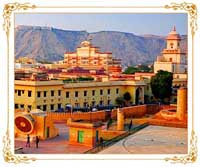
The only planned city of its time, Jaipur is encircled by a formidable wall. A young Bengali architect, Vidyadhar Bhattacharya formalised the city's plans according to a grid system in accordance with the principles of town planning set down in the Shilpa Shastra, an ancient Hindu treatise on architecture.
Jai Singh who was also an enthusiastic astronomer spent much time and money on building the Jantar Mantar, a solar observatory, which is still one of Jaipur's main attractions. People and culture
Lifestyle in the walled Pink City still has the flavour and ambience of old times. Except for increased crowds and motorised vehicles, nothing seems to have changed here. Right from the beginning it earned a reputation of being a leading trade city in India, which is still evident.
|
The royal sport of polo and Jaipur go hand in hand. A number of international polo tournaments are hosted here and are enjoyed equally by one and all. Prince Charles and the late Princess Diana have visited Jaipur during the annual Jaipur polo matches. The last Maharaja of Jaipur, Sawai Man Singh II breathed his last while playing polo in England during the Ascot week tournaments in June 1970. |
Speaking of Maharaja Sawai Man Singh II, his wife, still known as the Rajmata or Queen Mother of Jaipur, the gracious and charming Maharani Gayatri Devi, was once considered one of the most beautiful women in the world by Vogue.
Despite its size and the pressures of modern living, Jaipur has not suffered the traumas of city living as far as socialising goes. Life for the common people here is full of colour, joy and celebration. The year is marked with dozens of festivals and rituals, celebrated with music, dance and culinary delights. There is a joyous enthusiasm displayed in the celebration of varied events.
Landmarks
Amber Fort
|
Amber Fort The Fort is a classic, romantic Rajasthan fort-palace. Its construction was started by Man Singh I in 1592 and completed by his descendant Jai Singh I, and is a beautiful blend of Mughal and Hindu styles. Painted scenes of wars and hunting expeditions adorn the walls which are set with precious stones and mirrors. The main attractions are the Sukh Mandir or Temple of Contentment, cooled by a stunning water cascade and the Sheesh Mahal or Mirror palace. In a tiny pitch dark room with mirrors all over the ceiling, an attendant lights up candles and holds them for you creating a marvellous sight - twinkling stars on a clear night! In the foreground is the Maota Lake with stunning reflections of the splendid Amber Fort-Palace. The fort can be reached through snaking pathways on elephant back giving the visitor a truly royal experience. |
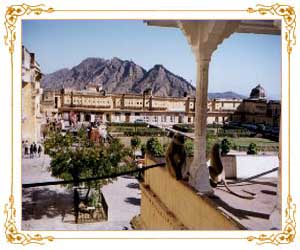 |
Jaigarh Fort
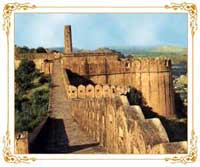 |
Within walking distance of Amber, it is one of the few military structures of medieval India. Named after Jai Singh II, the fort offers a great view of the plains from the Diwa Burj watchtower. Perched on a cliff and surrounded by huge battlements with inside walkways, the fort has retained its ancient splendour in palaces, gardens, reservoirs, a granary, an armoury, a well planned cannon foundry, several temples, a tall tower and the world's biggest cannon on wheels, Jai Ban, which was made in the fort's foundries. Used only once for a test firing, the cannonball, weighing 150 kgs landed 40 kms away, allegedly making "the brave tremble and aborting pregnant women." Another of Jaigarh's attractions is the elaborate water filtering and storage system which, within its watery depths, also housed the royal treasury. |
Nahargarh Fort
| Built by Jai Singh II in 1734 and extended in 1868, the fort is like a tiger standing on the crest of a hill overlooking the city below. The panoramic view of the sprawling city of Jaipur from here, especially after nightfall, is simply breathtaking. Along the ridge road it provides magnificent views down to the Man Sagar Lake. In the midst of this lake is a palatial duck blind, which was used by the erstwhile royal family to host shooting parties. |  |
The City Palace
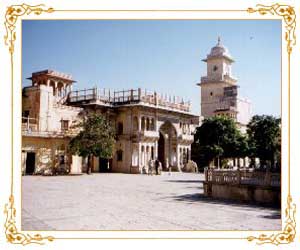 |
A delightful blend of Mughal and traditional Rajasthani architecture, the City Palace sprawls over one-seventh of the area in the walled city. The carved arches are supported by ornate grey-white marble columns with floral motifs in gold and coloured stones. Two carved elephants in marble guard the entrance. The retainers, whose families served generations of rulers, are now guides here. The palace houses a museum with a superb collection of Rajasthani costumes and the armoury of Mughals and Rajputs, including swords, some of which are inlaid with enamel and adorned with jewels. The art gallery has an excellent collection of miniature paintings, carpets, royal accoutrements and rare astronomical works in different languages. |
Jantar Mantar
| Ahis is the largest and best preserved of the five observatories built by Jai Singh II in different parts of the country. The complex instruments, whose setting as well as shape was scientifically designed, is a tribute to medieval Indian astronomy. The most striking instrument is the sundial. The shadow this casts moves upto 4 m an hour. The Ram Yantras are used for gauging altitudes. | 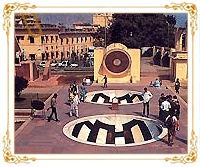 |
Hawa Mahal
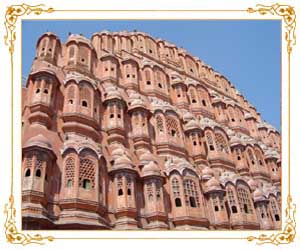 |
Entrance to the Hawa Mahal is from the rear end of the building. The ornamental facade of this "Palace of Winds" is an important landmark of Jaipur. The five-storey structure of pink sandstone has 953 niches and windows. It was built in 1799 by Pratap Singh and was a royal grandstand for palace women to watch the every-day life and processions of the city. |
Ram Niwas Bagh
A lush spacious garden with a zoo, an aviary, a greenhouse, a herbarlum, a museum and popular sports ground. It was built by Sawai Ram Singh II in 1868 AD as a famine relief project. The Albert Hall has an exquisite collection of sculptures, paintings and decorative ware. In the twilight it looks even more impressive with its subdued illumination. Especially noteworthy is the beautiful 16th century Persian carpet and Egyptian mummy. Recently, the Rabindra Manch, with an auditorium, a modern art gallery and an open-air theatre, has been added, to promote cultural events.
Govind Devji Temple
This spireless temple of Jaipur is dedicated to Lord Krishna. It is located in the central pavilion of the Jai Niwas Garden to the north of Chandra Mahal. The image of the patron deity, Govind Devji, was originally installed in a temple of Vrindavan, and reinstalled here by Sawai Jai Singh II as his family deity.
Swargasuli (Isar Lat)
The highest tower dominating the skyline of the western side of the Tripolia Bazaar. It was built by Sawai Ishwari Singh in 1749 AD to commemorate a grand victory.
Dolls' Museum
Pretty dolls from various countries are on display at the museum in the compound of a school, near the Police Memorial.
BM Birla Planetarium
The Planetarium offers unique audio-visual education and entertainment with its modern computerised projection system. For school groups concessions are available. Closed on the last Wednesday of every month.
Birla Temple
In milky white marble, the temple has intricate carvings and is fully air-conditioned!
Jain Temple
The exquisite Jain temple on the Agra Road has some of the most beautiful 19th century paintings in Jaipur style. Moti Doongari and Lakshmi Narayan Temple Moti Doongari is a privately owned hilltop fort built like a Scottish castle. The Ganesh Temple at the foot of the hill and the marvellous marble Lakshmi Narayan Temple built a few years back are noteworthy.
Statue Circle
The full-length exquisitely carved statue of Swai Jai Singh in white marble in the centre of the circle was erected under the newly planned scheme to pay homage to the founder of Jaipur.
Ghat ki Gunim
Beautifully landscaped gardens laid out in the 18th and 19th century dot the narrow gorge in the south-eastern corner of the walled city, along the road to Agra.
Sisodia Rani Garden
It has tiered multi-level gardens with fountains, water channels and painted pavilions and suites of living rooms. Amongst others, Vidhyadhar-ka-Bagh is the best preserved, with shady trees, flowing water, and an open pavilion.
Galtaji (20 km)
An ancient pilgrimage centre, lying beyond the gardens amidst low hills. Temples and pavilions amidst lush landscapes make it a delightful spot. The natural springs here are said to have curative properties. The small temple of the Sun god, built by Diwan Kriparam on the top of the highest peak is visible from all parts of the city.
Sanganer (16km)
The town is entered through the ruins of two tripolias or triple gateways. Sanganer is famed for textile block printing, papermaking and Jaipur blue pottery. So the shopper likes to visit here. In addition to its ruined palaces, Sanganer has exquisitely carved Jain temples.
Gaitor (15 km)
It is here that the Chhatris of Jaipur's rulers stand in an ambience of respectful tranquillity. The cenotaph of Maharaja Sawai Jai Singh II in white marble is the finest. Cenotaphs of Pratap Singh and Madho Singh II are noteworthy. The cenotaphs of the Maharanis of Jaipur are on Amber Road. Nearby is the Jal Mahal, a lake palace, which was the summer resort of the royal Rajput family.
Amer
It was the former capital of the Kachhwaha rulers of the old state of Dhundhar for seven centuries. Very little of the early structures survive now.
Amer Palace and Shila Mata Temple
Built over a period of two centuries the palace complex emerges dramatically from the placid waters
of the Maotha Lake and is approachable only through a steep path. Tourists often ride on elephant back to Singh Pol
and Jaleb Chowk. Two flights of stairs rise from one end of the chowk, one leading to the Shila Mata Temple and the
other to the palace complex. Raja Man Singh brought the image of the patron goddess, worshipped by thousands of devotees,
from Jessore in East Bengal, now in Bangladesh, to be installed here.
Diwan-e-Aam has a spectacular pillared hall and a double storied painted gateway. Ganesh Pol dominates the courtyard.
An elegant tiny garden in Charbagh style beyond the corridors has Sukh Niwas to its right and Jas Mandir to its left.
The latter combines Mughal and Rajput architecture seen in its beautiful interiors. There are intricately carved Jali
screens, delicate mirror and stuccowork and painted and carved dadoes. The proportioned Mohan Bari or Kesar Kyari in
the centre of the Maotha Lake and the Dilaram Bagh at its north end provides a spectacular view of the palaces above.
Samode (50 km)
It is known for its palace, which is now a heritage hotel and is about 40 kms from Jaipur. The highlight of the building is the exquisite Diwan-i-Khas, which is covered with original paintings and mirrorwork.
Bagru (35 km)
On the Ajmer Road, the ground level fort is still in good shape. It is noted for its hand-printed handloom industry which uses simple, basic techniques. The designs of these handlooms are in earthy colours.
Ramgarh Lake (32 km on the North east)
A huge artificial lake created by constructing a high bund amidst tree-covered hills. While the temple of Jamwa Mata and the ruins of the old fort are some of its antiquities, its beautiful landscape, especially during monsoons, makes it an idyllic picnic spot. now.
Bairath (86 km on the Shahpura-Alwar Road)
An important historical site with the excavated remains of a circular Buddhist temple, unique in Rajasthan. It is the earliest known temple in India. Bairath also has relics of the Mauryan, Mughal and Rajput periods. A mint constructed by Akbar, a beautiful Mughal garden and a remarkable monument with painted chhatris and walls built by Jahangir, along with other attractions.
Abhaneri (128 km north east off the Agra road near Bandikui)
A famous 7th-8th century AD temple of Harshad Mata and the stepwell known as Chanda Baodi are of interest. Two Jain temples are also present, which were built at a later period.
Sambhar (94 km)
The largest inland salt lake of India known for the holy Devayani Tank, the palace and the nearby Naliasar.
Jaisinghpura Khor (12 km off the Amer Road)
One of the settlements of the Meena tribe, it has a formidable fort, a Jain temple and a stepwell amid lush surroundings. Madhogarh-Tunga (40 km On the Bassi-Lalsot Agra Road) Tunga was witness to a historic battle fought between the Jaipur forces and Marathas. The fort is nestled amidst beautiful mango orchards.
Art and Entertainment
Jaipur was established with a vision of making it a leading centre of art, culture and craft. The Ghoomar is a popular dance. The `Dagar Bandhu' singers of Vedic origin and the famous 'Dhrupad Gahrana' are based in Jaipur. It is also a leading centre for the learning of Sanskrit, astrology, naturopathy, ayurveda and herbal treatment of all kinds. Jaipur has given to the world a number of poets and writers. There is a separate school of Rajput style of miniature paintings. The Gallery of Modern Art at Ravindra Rangshala is also worth a visit. The Jaipur Kathak Kendra or Centre for classical dance and Sangeet Sansthan or Institute of music, are important centres which impart dance and music lessons.
Festivals
Fairs are marked by grand processions with a strong local flavour, the most popular being Gangaur and Teej.
Gangaur Festival
Held in honour of goddess Parvati, this festival is held a few days after Holi and is celebrated in Jaipur on a grand scale. Primarily a festival for women, at this time married women pray for the welfare of their husbands and unmarried girls pray for a good husband. Festive processions are taken out, women draw water from wells, pick flowers and chant hymns to the goddess Parvati.
Teej Festival)
The largest inland salt lake of India known for the holy Devayani Tank, the palace and the nearby Naliasar.
Holi
Jaipur's Chauhan Stadium comes alive during the Elephant Festival on Holi, the festival of colours. Playing polo atop bedecked elephants is an experience in itself.
Makar Sakranti
Kite flying is a major event every Makar Sakranti with the skies dotted with kites, and people of all ages participating in the youthful festivities.
Accommodation
General Information
The Raj Vilas, run by the Oberoi group, is one of the better known hotels of Jaipur. The rooms are tastefully decorated. Tented accommodation and villas are also available inside the complex. The Trident hotel is also part of the same group. Rambagh Palace, a former residence of the Maharaja of Jaipur, is a stylish complex and now a part of the Taj chain of hotels. One can visit The Polo Bar at the opulent Rambagh Palace for cocktails. One of the finest bars - it has a marble fountain in the middle and lots of polo memorabilia on the walls including the famous Tatler cartoon. Samode Haveli, a 200 year old building was the residence of the British during the Raj. The large pool and restaurant are worth visiting. Other top end hotels include the Holiday Inn, and the Hotel Jaipur Ashok. The Madhuban, run by a helpful family offers free pick-ups from the bus stand and the railway station. Hotel Meghniwas is a mid range hotel and is in a well-kept condition.
Hotel Bissau Palace with its roof top restaurant and an interesting library, is another place where you don't shell out exorbitantly for the services offered. RTDC runs two hotels in Jaipur, the Hotel Teej and the Hotel Gangaur, named after the festivals of the region. The Jaipur Inn, lets you camp on its lawn. This budget accommodation is ideally suited for groups of travellers. Atithi Guest House, Hotel Diggi Palace and RTDC's Hotel Swagatam also offer budget solutions for your stay in Jaipur.
The pre-paid autorickshaw stand is the best place to go to venture into the city looking for accommodation, or else one is nagged by the auto rickshaw touts whom you land up paying commission to for taking you to a particular hotel. The tourist reception Centre has details of Jaipur's paying Guest Scheme.
Places to Eat
Niro's, which celebrated its Golden Jubilee recently, offers a wide variety of food ranging from Indian veg. and non-veg, Chinese and Continental. American Ice Cream Sodas are available here. The Golden Dragon Restaurant specialises in Chinese cuisine. The Copper Chimney, The Indian Coffee House and the Chanakya Restaurant are some budget places to eat. The Polo Bar at the Rambagh Palace is a great place to enjoy a drink.
How to Get There
Air
Jaipur is well connected to Delhi, Mumbai and Calcutta by air. Flights to Udaipur, Jaisalmer and Aurangabad in Gujarat are also operational on a weekly basis. To get to the city, which is almost 15 kms one has to take an auto rickshaw or a taxi.
Rail
Most of the railway lines into Jaipur have been converted to broad gauge, which is not the case for most other cities in the state. A special luxury train, the Palace on Wheels starts from Delhi on a round trip of Rajasthan.
Road
From the main bus station on Station Road, buses are available to every nook and corner of the state. Express and Deluxe buses are also run by the Rajasthan State Transport Corporation. A cluster of private run bus operators is near the Polo Victory Cinema. The pre-paid auto rickshaw service is the most assured way of getting around the city. Cycle rickshaws are available. Bicycles are also available on hire.
Shopping
The Rajasthali Emporium sells an interesting range of handicrafts from all over the state. The Juneja Art Gallery has a fabulous range of contemporary paintings by predominantly Rajasthani artists. Jaipur is known for its semiprecious gems, marble statues, costume jewellery and textile prints. There is a timeless appeal to Jaipur's colourful bazaars where one can shop for Rajasthani handlooms, jooties (traditional shoes), sarees and trinkets. Typical of the medieval times, almost all kinds of commodities are sold at teeny-weeny stores. Shopkeepers, hawkers and vendors all vie for space and the bazaars are as much for gatherings and socialising. All kinds of displays, advertisements, street dancers and singers find their place there. This is one of the few places where shoppers can watch skilled artisans producing the very articles for sale. The main markets are along Jauhari Bazar, Badi Chaupar and M. I. Road. Chhoti Chaupar bursts with life every morning and winds up every evening. Shops specialising in precious and semi-precious stones, ornaments and jewellery are to be found on and along Jahauri Bazar. To see the celebrated minakars, kundan workers, gem-cutters and ornament-makers at work, you can visit Jadiyon-ka-Rasta, Gopal ji-ka-Rasta, Haldiyon-ka-Rasta and the adjoining lanes.
Jaipur City Guide
| Location: | Rajasthan, India |
| Significance: | Capital City of Rajasthan State |
| Best Season: | October To March |
| Language: | Hindi, Urdu & Rajasthani |
| Altitude: | 236.53 Meters (Above Sea-Level) |
| Rainfall: | 31.87 cms (Average) |
| Climate (Summer): | Max. 45.2 'C & Min. 36.6 'C (Mean) |
| Climate (Winter): | Max. 27.5 'C & Min. 10.5 'C (Mean) |
| Clothing (Summer): | Light Tropical / Cottons |
| Clothing (Winter): | Light Woollens |
| Reach By Air: | Multiple airlines connect to Jaipur with major cities of the country |
| Reach By Railways: | Jaipur is well connected with railways to major cities of the country |
| Reach By Road: | Good motorable roads (with regular buses & taxis) connect Jaipur with Delhi 258 kms, Agra 236 kms, Bikaner 321 kms, Udaipur 405 kms, Ajmer 131 kms, Jodhpur 316 kms, Bharatpur 176 kms, Jaisalmer 638 kms, Bombay 1202 kms, etc. |
© Dr. Swati Agarwal 2009-2024. All Rights Reserved. |
Powered By: Bhupati IT & Legal Services & CSP |


